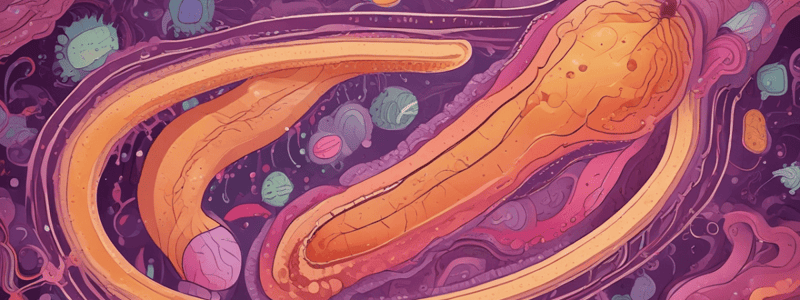Podcast
Questions and Answers
How do monoglycerides and free fatty acids leave micelles inside the epithelial cells?
How do monoglycerides and free fatty acids leave micelles inside the epithelial cells?
- By facilitated diffusion (correct)
- By simple diffusion
- By active transport
- By endocytosis
What is the fate of triglycerides inside epithelial cells?
What is the fate of triglycerides inside epithelial cells?
- They are exocytosed into the bloodstream
- They are broken down into free fatty acids
- They form micelles for absorption
- They are re-synthesized from monoglycerides and fatty acids (correct)
How do chylomicrons leave the epithelial cells after being formed?
How do chylomicrons leave the epithelial cells after being formed?
- Through simple diffusion
- By exocytosis (correct)
- Via active transport
- By endocytosis
By what process do amino acids exit the epithelial cells at the basal membrane?
By what process do amino acids exit the epithelial cells at the basal membrane?
How are small peptides absorbed into epithelial cells?
How are small peptides absorbed into epithelial cells?
What happens to the small peptides once they are absorbed into the epithelial cells?
What happens to the small peptides once they are absorbed into the epithelial cells?
How are fats able to diffuse through the luminal membrane after being broken down into micelles?
How are fats able to diffuse through the luminal membrane after being broken down into micelles?
What triggers cholecystokinin (CCK) to be released?
What triggers cholecystokinin (CCK) to be released?
Which cells in the pancreas does cholecystokinin (CCK) stimulate?
Which cells in the pancreas does cholecystokinin (CCK) stimulate?
What enzyme activates trypsinogen in the pancreas?
What enzyme activates trypsinogen in the pancreas?
How are disaccharides broken down in the small intestine for absorption?
How are disaccharides broken down in the small intestine for absorption?
How are glucose and lactose absorbed into epithelial cells in the small intestine?
How are glucose and lactose absorbed into epithelial cells in the small intestine?
Which mechanism is responsible for fructose entering epithelial cells in the small intestine?
Which mechanism is responsible for fructose entering epithelial cells in the small intestine?
How do glucose, galactose, and fructose exit epithelial cells in the small intestine?
How do glucose, galactose, and fructose exit epithelial cells in the small intestine?
What is the function of exocrine secretions of the pancreas?
What is the function of exocrine secretions of the pancreas?
During the oesophageal stage of swallowing, what happens to the gastroesophageal sphincter?
During the oesophageal stage of swallowing, what happens to the gastroesophageal sphincter?
What role does the epiglottis play during swallowing?
What role does the epiglottis play during swallowing?
Which enzyme is responsible for breaking down peptide linkages in the small intestine?
Which enzyme is responsible for breaking down peptide linkages in the small intestine?
What triggers the release of secretin in the digestive system?
What triggers the release of secretin in the digestive system?
Which of the following is a voluntary action in the swallowing process?
Which of the following is a voluntary action in the swallowing process?
What prevents food from entering the nasal passage during swallowing?
What prevents food from entering the nasal passage during swallowing?
What initiates impulses to the salivary centre in the medulla during the simple reflex of saliva production?
What initiates impulses to the salivary centre in the medulla during the simple reflex of saliva production?
What causes salvation in the conditioned reflex of saliva production?
What causes salvation in the conditioned reflex of saliva production?
Which type of nerves are innervated to stimulate the salivary glands and promote saliva production?
Which type of nerves are innervated to stimulate the salivary glands and promote saliva production?
Which gland is responsible for producing watery saliva when stimulated by the parasympathetic nervous system?
Which gland is responsible for producing watery saliva when stimulated by the parasympathetic nervous system?
Which division of the autonomic nervous system controls saliva production and increases the production of thick mucus saliva?
Which division of the autonomic nervous system controls saliva production and increases the production of thick mucus saliva?
What triggers the reflex for swallowing?
What triggers the reflex for swallowing?
Which part of the brain is responsible for controlling the swallowing process?
Which part of the brain is responsible for controlling the swallowing process?
Which type of saliva does the sympathetic nervous system increase production of?
Which type of saliva does the sympathetic nervous system increase production of?
What initiates impulses via afferent nerves to the salivary center in the medulla during the simple reflex of saliva production?
What initiates impulses via afferent nerves to the salivary center in the medulla during the simple reflex of saliva production?
How are amino acids absorbed into epithelial cells?
How are amino acids absorbed into epithelial cells?
What is the mechanism by which small peptides are absorbed by epithelial cells?
What is the mechanism by which small peptides are absorbed by epithelial cells?
How do triglycerides leave epithelial cells?
How do triglycerides leave epithelial cells?
What is the fate of chylomicrons after leaving the basal membrane?
What is the fate of chylomicrons after leaving the basal membrane?
How do monoglycerides and free fatty acids enter epithelial cells?
How do monoglycerides and free fatty acids enter epithelial cells?
What is the role of pancreatic lipase in fat absorption?
What is the role of pancreatic lipase in fat absorption?
Which cells in the pancreas produce cholecystokinin (CCK)?
Which cells in the pancreas produce cholecystokinin (CCK)?
How are disaccharides broken down in the small intestine for absorption?
How are disaccharides broken down in the small intestine for absorption?
What triggers the release of secretin in the digestive system?
What triggers the release of secretin in the digestive system?
How do glucose, galactose, and fructose exit epithelial cells in the small intestine?
How do glucose, galactose, and fructose exit epithelial cells in the small intestine?
Amino acids are absorbed into epithelial cells via K+ symporters.
Amino acids are absorbed into epithelial cells via K+ symporters.
Small peptides are broken down into amino acids by intracellular lipases.
Small peptides are broken down into amino acids by intracellular lipases.
Glucose exits epithelial cells in the small intestine via active transport.
Glucose exits epithelial cells in the small intestine via active transport.
Bile salts breakdown fats into chylomicrons inside epithelial cells.
Bile salts breakdown fats into chylomicrons inside epithelial cells.
The water-soluble chylomicrons exit epithelial cells via exocytosis.
The water-soluble chylomicrons exit epithelial cells via exocytosis.
Names of the proteolytic enzymes in inactive and active form.
Names of the proteolytic enzymes in inactive and active form.
what activates trypsinogen and from where?
what activates trypsinogen and from where?
2 pancreatic hormonal secretions
2 pancreatic hormonal secretions
what type of nerve regulates digestive functions?
what type of nerve regulates digestive functions?
what autonomic nerve regulates digestion and how?
what autonomic nerve regulates digestion and how?
what cells secrete secretin?
what cells secrete secretin?
Flashcards
Swallowing stages
Swallowing stages
Oral/Oropharyngeal, oesophageal, and gastric stages involving 31 pairs of muscles.
Pancreatic Juice
Pancreatic Juice
Watery alkaline solution (sodium bicarbonate) produced by duct cells in the pancreas.
Proteolytic Enzymes
Proteolytic Enzymes
Inactive enzymes (trypsinogen, chymotryspinogen, procarboxypeptidase) released by acinar cells, activated in the duodenum.
Amino Acid Absorption
Amino Acid Absorption
Signup and view all the flashcards
Fat Breakdown
Fat Breakdown
Signup and view all the flashcards
Triglyceride Resynthesis
Triglyceride Resynthesis
Signup and view all the flashcards
Chylomicron Formation
Chylomicron Formation
Signup and view all the flashcards
Disaccharide Breakdown
Disaccharide Breakdown
Signup and view all the flashcards
Monosaccharide Absorption
Monosaccharide Absorption
Signup and view all the flashcards
Monosaccharide Exit
Monosaccharide Exit
Signup and view all the flashcards
Microvilli Function
Microvilli Function
Signup and view all the flashcards
Enteropeptidase
Enteropeptidase
Signup and view all the flashcards
Disaccharidases
Disaccharidases
Signup and view all the flashcards
Aminopeptidases
Aminopeptidases
Signup and view all the flashcards
Study Notes
Swallowing
- 3 stages of swallowing: oral/oropharyngeal stage, oesophageal stage, and gastric stage
- Involved 31 pair of muscles
- Voluntary swallowing is initiated by pushing the tongue against the hard palate
- The bolus is pushed to the back of the pharynx, and the ovula is elevated to seal off the nasal passage
- Food is prevented from entering the trachea by elevation of the larynx and closure of vocal folds (glottis and epiglottis)
Exocrine Secretions of Pancreatic Juice
- Pancreatic juice is a watery alkaline solution (sodium bicarbonate) produced by duct cells
- Proteolytic enzymes are produced by acinar cells and released in inactive form
- Enzymes are activated by enzymes in duodenal membrane in small intestine
- Trypsinogen, chymotryspinogen, and procarboxypeptidase are activated to trypsin, chymotrypsin, and carboxypeptidase
- Each different type of proteolytic enzyme attacks different peptide linkages
Protein Reabsorption
- Amino acids are absorbed into epithelial cells via Na+ symporters
- Amino acid symporters are selective for different amino acids
- Some small peptides are also absorbed by H+ symporter and broken down into amino acids by intracellular peptidases
- Amino acids exit the cell at basal membrane passively via carriers (facilitated diffusion) and enter the blood via simple diffusion
Fat Absorption
- Pancreatic lipase and bile salts break down fats into micelles
- Micelles passively diffuse through membrane, and monoglycerides and free fatty acids leave the micelles and passively diffuse through the luminal membrane
- Inside epithelial cells, monoglycerides and fatty acids are re-synthesised into triglycerides
- Triglycerides aggregate coated with lipoprotein from the ER to form water-soluble chylomicrons
- Chylomicrons leave the basal membrane via exocytosis and enter the lymphatic system, unable to cross the basement membrane of the capillaries
Carbohydrate Reabsorption
- Carbohydrates are normally found in the form of disaccharides such as maltose, sucrose, and lactose
- Disaccharides are broken down into absorbable monosaccharides units of glucose, galactose, and fructose
- Glucose and lactose are absorbed into epithelial cells by symport with Na+ (SGLT = sodium glucose transporters)
- SGLT is energy-dependent secondary active transport located on the luminal membrane
- Fructose enters the cell passively by facilitated diffusion by a Glut-5
- Glucose, galactose, and fructose exit the cell at basal membrane by passive facilitated diffusion via Glut-2 and enter the blood via simple diffusion
Absorption in Small Intestines
- Special hair-like projections on the luminal surface of the small intestine = microvilli form the brush border
- Microvilli contain 3 types of membrane-spanning proteins that function as membrane-bound enzymes
- Enteropeptidase activates pancreatic proteolytic enzyme called trypsinogen
- Disaccharidases break down disaccharides into monosaccharides
- Aminopeptidases hydrolyse small peptide fragments into amino acids
- These hair-like projections are constantly being replaced due to the harsh environment and are sensitive to cancer treatment
Studying That Suits You
Use AI to generate personalized quizzes and flashcards to suit your learning preferences.



